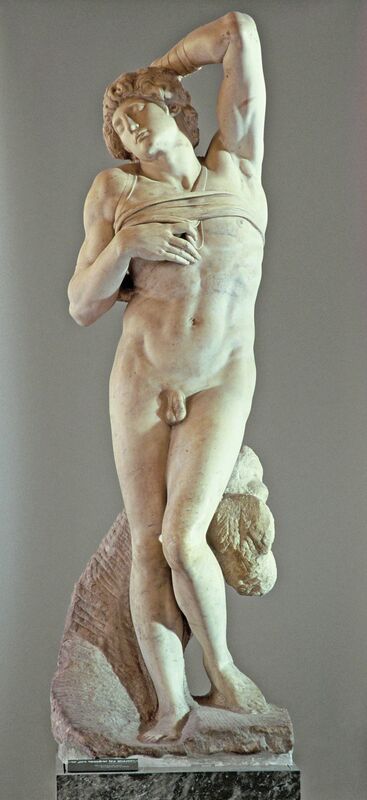The story behind St Sebastian, who is a saint from the Roman age, became a martyr due to him not renouncing his Christian faith during a rampant campaign by Roman people to persecute Christians. He had concealed his faith until he could no longer. In the painting we see that he is shot with one arrow. In many versions of this story we find the phrasing that he was left looking like a “sea urchin” due to how many arrows were shot into him to kill him for his crimes. In this painting we only see one arrow, and this particular painting was done by Angel Zarraga.
In terms of the meaning of this painting, we start with the title. A votive offering is one or more objects deposited or displayed, without the intention of recovery or use, in a sacred place. These offerings are considered to help people gain a favorable status with their chosen supernatural forces/religious god(s). In this painting St. Sebastian, takes on the same position as the Dying Slave by Michelangelo. This pose symbolizes life being drained from a person to eventually become a lifeless sack of matter. This is the acceptance of his release from his struggles of his life.
To the left of him, St. Irene sits, with her hands clasped together in a praying stance. In the story, she is known as the person who was tasked with cleaning the body of St. Sebastian, but when found alive, she nursed him back to health after being shot with arrows. To the right of him, we see a passage, which reads as follows: “Lord, I do not know how to celebrate you as a poet does in complicated verses, but Lord accept this rough and humble work I have made with my mortal hands. Angel Zarraga.” We see and read this passage as a note from the artist himself. The Mexican painter, Angel Zarraga, used this work to show his allegiance to God and his work as an offering.
In some interpretations, Angel Zarraga uses this painting as an example of his own life. His inner self being St. Sebastian and his mother being St. Irene. He explains that his mother used to teach him how to pray in the exact position. We don’t see a lot of pain on St. Sebastian’s face in this depiction and because of this reasoning, it is believed that, in this interpretation, it is from a divine encounter and being close to the divine through mediums.
Essentially, this piece covers the bliss that comes with devoting their life to God as well as being able to encounter the divine within experiences either prayer, offering, or pain.
